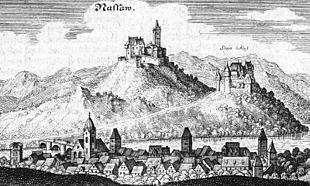Stone to Nassau


The Stein zu Nassau family (also vom and zum Stein ) is a Nassau nobility.
history
The family was first mentioned in a document in 1195, a reliable line of tribe begins with Heinrich vom Stein, who can be documented from 1253 to 1255. With the rule of Stein zu Nassau, the family belonged to the Middle Rhine Imperial Knighthood and later acquired the status of Imperial Baron.
The property included the Steinsche Burg and Steinsche Stadtschloss as well as the Steinsche Weingut in Lorch (Rheingau) . In 1816 the baron Heinrich vom und zum Stein acquired the secularized Cappenberg monastery in Westphalia. After the von und zum Stein family died out, these goods were inherited by the Count von Kanitz family in 1926 .
Prominent representatives of the family are Marianne vom und zum Stein and Heinrich Friedrich Karl vom und zum Stein .
Steinsches City Palace in Nassau
Cappenberg Castle , Westphalia
coat of arms
In gold, a red rose with blue clusters . Increased in the 14th century by some members with five-stitched blue tournament collars . The helmet, with its red and gold covers, had been equipped with two peacock fronds since 1352 . From 1400, the helmet was adorned with a yellow dog's torso with a red collar. The dog later became a silver donkey with a black crown around its neck. The helmet covers are black and silver. The coat of arms was improved and later united with that of the extinct Schöneck family .
Marriage coat of arms of Brendel von Homburg- Stein zu Nassau at Friedberg Castle (16th century)
literature
- Genealogical manual of the nobility - Adelslexikon , Volume XIV, Limburg / Lahn 2003. S. 59f.







